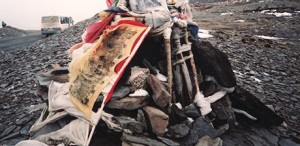
સેક્રેડ નેચરલ સાઇટ પહેલ નિયમિત લક્ષણો “સંરક્ષણ અનુભવો” સંરક્ષકો ના, રક્ષિત વિસ્તાર મેનેજરો, વૈજ્ઞાનિકો અને અન્ય માતાનો. આ વખતે અમે ડૉ.ના અનુભવને દર્શાવી રહ્યાં છીએ. જ્હોન સ્ટડલી જેઓ ના ફેલો છે (બ્રિટિશ) રોયલ જિયોગ્રાફિકલ સોસાયટી. તેમણે એથનો-ફોરેસ્ટ્રી કન્સલ્ટન્ટ તરીકે કામ કરતાં ઉચ્ચ એશિયામાં તેમનું મોટાભાગનું જીવન વિતાવ્યું છે. પર સંપૂર્ણ અહેવાલ માટે અહીં ક્લિક કરો “ખામના પવિત્ર સ્થળો”.
સાઇટ
ખામ એ પૃથ્વી પરના સૌથી વિશિષ્ટ જૈવિક પ્રદેશોમાંનું એક છે. તે કિંઘાઈ-તિબેટીયન ઉચ્ચપ્રદેશ અને ચીનના સિચુઆન અને યુનાન પ્રાંતની વચ્ચે આવેલું છે, 'સાંસ્કૃતિક તિબેટ'ના ત્રણ પ્રદેશોનો સમાવેશ. ખામમાં જૈવ-સાંસ્કૃતિક વિવિધતાના રક્ષકો પવિત્ર કુદરતી સ્થળોની ત્રણ પરંપરાઓને ઓળખે છે, અથવા ધાર્મિક રીતે સુરક્ષિત બિડાણો. બે તિબેટીયન બૌદ્ધ છે અને તેમાં પર્વતોનો સમાવેશ થાય છે સાથે મેળવો અને ખીણો sbas yul. ત્રીજી પરંપરા પૂર્વ-બૌદ્ધ વૈમનસ્યવાદી 'પર્વત સંપ્રદાય' દ્વારા વર્ગીકૃત થયેલ છે જેઓ રક્ષણ કરે છે ફરીથી આરઆર બિડાણો જે દૈવીત્વ દ્વારા મૂર્ત સ્વરૂપ અથવા અંકિત થયેલ છેyul-lha માનવ વ્યક્તિત્વ સાથે. આ yul-lha બાયોફિઝિકલ સંસાધનોની માલિકી ધરાવે છે અને બિડાણ સ્પષ્ટ પ્રકૃતિ સંરક્ષણ દ્વારા વર્ગીકૃત થયેલ છે. આવા પવિત્ર પ્રાકૃતિક સ્થળો અનલોગ કરેલ જંગલો હોઈ શકે છે, ધાર્મિક વિધિ btsas, વિવિધ જળ કેચમેન્ટ ri rgya klung અન્ય લોકો વચ્ચે.
સંરક્ષકો
ખામના શામન અને પાદરીઓ ઘણીવાર વૃક્ષો વિશે જાણકાર હોય છે, છોડ અને પ્રાણીઓ અને પર્યાવરણીય વાર્તા કહેવા અને ટોપોકોસ્મિક મધ્યસ્થીમાં મહત્વપૂર્ણ ભૂમિકા ભજવે છે. ધાર્મિક દૃષ્ટાંતો tટોપી સ્વદેશી જીવન આધ્યાત્મિક જીવનના સ્ત્રોતોના આદર પર આધારિત છે, ખોરાક, કપડાં અને આશ્રય જે કુદરત આપે છે. આ આધ્યાત્મિક શક્તિઓ પ્રત્યે કૃતજ્ઞતાની ભાવના પેદા કરે છે સર્જન અને પ્રકૃતિમાં. ધાર્મિક કેલેન્ડર સ્થળાંતર કરનારા પક્ષીઓ જેવી કુદરતી ઘટનાઓ પર આધારિત છે, અમુક છોડનું મોર અથવા ગ્રહોની હિલચાલ. લઘુમતી રાષ્ટ્રીયતાઓમાં કુદરતી સંસાધન સંભાળની મજબૂત પરંપરા હોવાનું જણાય છે જે તેમની અનન્ય ભાષાઓમાં પણ સમાયેલ છે..

કુલુકે ખાતે એક વૈમનસ્યવાદી કેર્ન લા-બત્સાસનો ઉપયોગ સામાન્ય રીતે પ્રાદેશિક આત્માઓ યૂલ-લ્હાના સન્માન માટે કરવામાં આવે છે અને તે ધાર્મિક રીતે સુરક્ષિત બિડાણમાં સ્થિત છે.. તે પ્રાર્થના ધ્વજથી ઢંકાયેલું છે જે પવનના ઘોડા rlung-rta દર્શાવે છે. પવન ઘોડો એ બ્લા અથવા આત્માનું રૂપક છે અને સુખાકારીનું પ્રતીક છે.
ધમકીઓ
એનિમિસ્ટિક અને શામનિસ્ટિક સાઇટ્સ જોખમમાં છે અને તિબેટીયન બૌદ્ધ સાઇટ્સ હાન ચાઇનીઝ દ્વારા લોગિંગ અને પુનર્વસન જેવી બાહ્ય અસર તરીકે વધુને વધુ જોખમમાં છે.. આ પ્રવૃત્તિઓને કારણે વાતાવરણમાં પરિવર્તન આવ્યું છે, ધોવાણ અને બરફની આફતો તેમજ વનસ્પતિ અને પ્રાણીસૃષ્ટિની વિવિધતામાં ઘટાડો અને સ્વદેશી સંસ્કૃતિઓના અસ્તિત્વ પર અસર. જીતવા માટેના પડકારોનો સમાવેશ થાય છે:
- વિકૃત આર્થિક સિદ્ધાંત ભૌતિકવાદી મૂલ્યો અને પશ્ચિમી વિજ્ઞાનના સાંસ્કૃતિક ઉચ્ચવાદ પર કેન્દ્રિત છે જે સંકુચિત આયોજન અને નીતિમાં પરિણમે છે,
- સાંસ્કૃતિક એસિમિલેશન અને નવા બિડાણ ચળવળ દ્વારા મજબૂર વિચરતી લોકોનું બેસાળીકરણ (ઉ.દા. ઐતિહાસિક ચરાઈ જમીન પર ફેન્સીંગ),
- વિકાસ એજન્ડા લાદવો જે સત્તા સંબંધોમાં અસમાનતાઓથી અજાણ છે,
- ની ભેળસેળ “જડ” અને “તિબેટીયન બૌદ્ધ” પવિત્ર સ્થળ અને જગ્યાનો અનુભવ.
દ્રષ્ટિ
સ્થાપના કરીને પવિત્ર પ્રાકૃતિક સ્થળો અને ખામના જૈવ-સાંસ્કૃતિક વિવિધતાની ખાતરી કરવી “સાંસ્કૃતિક મેપિંગ” ના રોજગાર દ્વારા વધારો “જ્ઞાન દલાલો”.
વાંચો સંપૂર્ણ સંરક્ષણ અનુભવ અથવા મુલાકાત લો આર્કાઇવ






